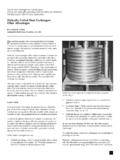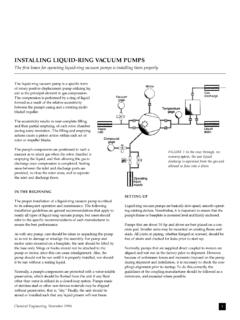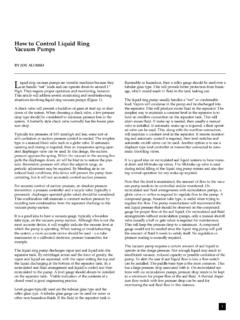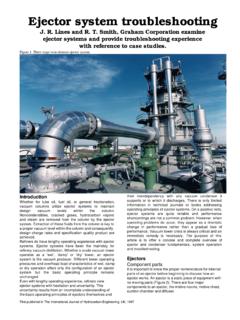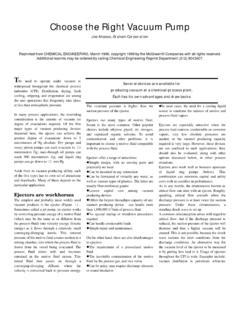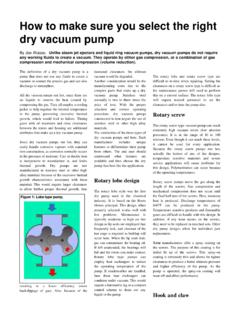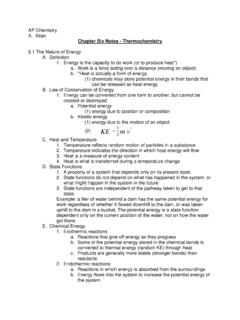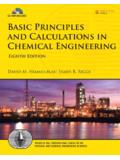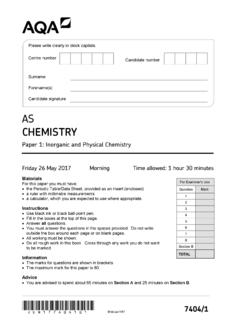Transcription of Understand vacuum-system fundamentals
1 Understand vacuum - system fundamentalsProperly operating ejectors and condensers is important in maximizing vacuum tower gas-oil yieldG. R. MARTIN, PROCESS CONSULTING SERVICES, Grapevine, TexasJ. R. LINES, GRAHAM MANUFACTURING CO., INC., Batavia, New YorkS. W. GOLDEN, Glitsch, Inc., Dallas, TexasCrude vacuum unit heavy vacuum gas-oil (HVGO) yield issignificantly impacted by ejector- system performance, espe-cially at conditions below 20 mmHg absolute pressure. A deepcutvacuum unit, to reliably meet the yields, calls for proper design ofall the major pieces of equipment.
2 Understanding vacuum ejectorsystem impacts, plus minimizing their negative effects equalsmaximum gas yield. Ejector- system performance may be adverselyaffected by poor upstream process impacts of optimum ejector performance are more pro-nounced at low flash-zone pressures. Gas-oil yield improvementsfor small incremental pressure reductions are higher at 8 mmHgthan at 16 mmHg. Commercial operation of a column with a top pressure and 10 mmHg flash-zone pressure is possi-ble. Designing a deepcut vacuum unit calls for a balance betweenpractical limits of furnace design, column diameter, utility con-sumption and ejector- system size.
3 Commercial performance of adeepcut vacuum unit operating at a HVGO true boiling point(TBP) cutpoint of 1,150 F highlights the impact of off-designejector performance on gas-oil yield. Understanding the vacuumejector- system fundamentals is critical to maintaining performance at deepcut vacuum column pressuresmay be independently or concurrently affected by: Atmospheric column overflash, stripper performance or cutpoint vacuum column top temperature and heat balance Light vacuum gas-oil (LVGO) pumparound entrainment tothe ejector system Cooling-water temperature Motive steam pressure Non-condensible loading, either air leakage or cracked light-endhydrocarbons Condensible hydrocarbons Intercondenser or aftercondenser fouling Ejector internal erosion or product build-up system vent back ejector- system gas loading lowers column pressure,thereby increasing gas-oil yield.
4 By optimizing process perform-ance when processing West Texas Intermediate (WTI) crude, thegas-oil yield can be increased by vol%. This represents 1,150bpd of incremental gas-oil recovery for a 150,000-bpd an average $5/bbl gas-oil differential over vacuumresidue, incremental annual revenue is $2 million. Experiencewith deepcut vacuum unit operation on WTI crude has shownthat vacuum column pressure is strongly impacted by atmospher-ic column operation and LVGO pumparound Processing, October 19941 Fig. 1. Gas-oil 2. Feed enthalpy vs.
5 YIELDSThe gas-oil yield on a crude vacuum column is controlled by feedenthalpy. If more heat can be added to the reduced crude at a givencolumn pressure, more oil is vaporized. A good furnace design isrequired to reliably meet the coil outlet temperature requirementsof a deepcut operation without excessive cracked-gas 1 shows the impact on gas-oil yield, assuming a given qualityof WTI reduced crude. The curves are in terms of vacuumresidue yield as a percent of whole crude. Fig. 2 represents feedenthalpy as a function of temperature and pressure.
6 Figs. 1 and 2are based on the same atmospheric residue composition assuminga crude unit charge of 40,000 bpd. The effect of column temper-ature and pressure on gas-oil yield is highlighted. Gas-oil yieldimprovements for small incremental pressure reductions are high-er at low column pressures than at higher example, a 2 mmHg pressure reduction is made for columnsoperating at 16 mmHg and 8 mmHg. Both have a constant flash-zone temperature of 760 F. Lowering pressure from 16 to 14mmHg and from 8 to 6 mmHg will increase gas-oil yield and , respectively.
7 This trend is more dramatic forlarger spreads in operating pressures. The column top pressurevaried between 4 and 16 mmHg and was caused by the processand utility is important to achieve lower pressures while meeting the practi-cal limits of furnace design and minimizing cracked-gas : a vacuum unit is to minimize residue yield to 9% basedon whole crude. From Figs. 1 and 2 a column operating at 6mmHg and 730 F flashzone pressure and temperature will havethe same gas-oil recovery as a column at 14 mmHg and 780 two cases have a feed enthalpy differential of with the higher pressure requiring a higher FUNDAMENTALSGas load.
8 The ejector- system loading consists of: Non-condensibles like cracked gas from the furnace and airleakage Condensible hydrocarbons carried with non-condensibles Entrainment Furnace coil steam Tower stripping and a small amount of condensible gases aregenerated in the furnace. Cracking is most severe in dry vacuum -tower operations with furnace-outlet temperatures above 750 F. Aproper furnace design will minimize cracked hydrocarbon operations with insufficient quench to the tower bootcan also cause cracked-gas formation. The quench distributionquality to the boot should be included in the vacuum towerdesign.
9 Ejector load is also affected by poor crude stripping in theatmospheric crude tower. Cause: damaged or an insufficient num-ber of stripping trays, improperly designed trays or insufficientstripping The operating principle of an ejector is to convert pres-sure energy of the motive steam into velocity. This occurs byadiabatic expansion from motive steam pressure to suction-loadoperating pressure. This adiabatic expansion occurs across a con-verging and diverging nozzle (Fig. 3). This results in supersonicvelocity off the motive nozzle, typically in the range of mach 3 to4.
10 In actuality, motive steam expands to a pressure lower than thesuction load pressure. This creates a low-pressure zone for pullingthe suction load into the ejector. High-velocity motive steamentrains and mixes with the suction gas load. The resulting mix-ture s velocity is still , the mixture enters a venturi where the high velocity recon-verts to pressure. In the converging region, velocity is convertedto pressure as cross-sectional flow area is reduced. At the throatsection, a normal shock wave is established. Here, a dramaticboost in pressure and loss of velocity across the shock waveoccurs.
